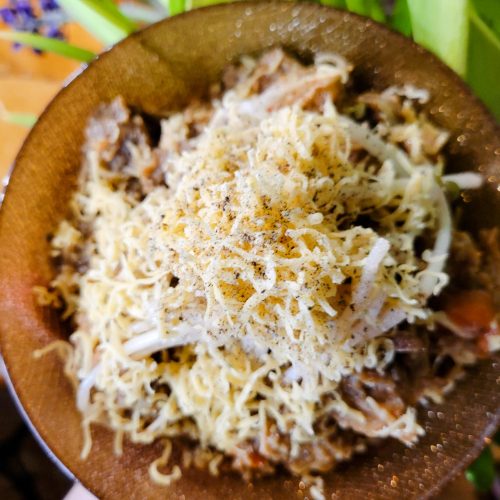
Curry w/ Mini Potatoes, Carrots, & Guinness
This Guinness Curry consists of multicolored mini potatoes, carrots, onion, jalapeños, garlic, coconut milk, sprouts, and rattlesnake cheddar. Feel free to mix and match in your own fruits and vegetables. As well as adjusting the peppers and cheese selection to fit your own spice level. But this truly is a fun and unique way to make make soup!
Equipment
- Large Pot
- Stovetop
Ingredients
- 1 lbs. mini potatoes diced
- 3 carrots diced
- 1 gnob onion diced
- 1 jalapeño minced
- 3 cloves garlic minced
- 1 Guinness 12 oz.
- 2 cans coconut milk
- dash chili powder
- dash coriander
- dash cumin
- dash salt
- dash pepper
- handful sprouts (optional)
- handful rattlesnake cheddar (optional)
Instructions
- Add all of the ingredients to a large pot.
- Simmer for at least 2-4 hours. You want the liquid to reduce in half. If it’s reducing too quickly, add water and turn down the temperature. If it isn’t reducing fast enough, bring to a boil again and reduce to a slightly higher temperature.The longer that you cook, the more the flavors will permeate the ingredients, so simmering at a lower temperature for longer is always an option. I’ll sometimes lower the temperature to a very light simmer and pretty much leave it be for 6-8 hours.
- Serve either immediately or the next day.Curry will continue to the absorb the spices the more time passes. It’s one of those dishes that I like to make ahead of time because it often tastes better after the flavors have had time to set overnight.
- I also added sprouts and rattlesnake cheddar to the top of this curry. This is optional, but a fun way to mix in some heat if you're up for it!
Tips, Tricks, & Notes
- Guinness Draught, Guinness Extra Stout and Guinness Foreign Extra Stout don't use isinglass in the filtration process and are vegan (Guinness' "Frequently Asked Questions").
To make the curry spicier, put more hot peppers when you cook the squash and lentils. Peppers added in the beginning stage will have a slower, more robust flavor that permeates through the dish. Peppers added towards the end of the cooking process will have more of a kick in the teeth, mouth burn. - If the curry absorb too much moisture, you may need to add more water. This is to taste. I tend to like a thicker curry with larger chunks, much like a thick stew. If you’re in the other camp that likes a more liquid curry, don’t hesitate to add more water. If you’re unsure, taste periodically and adjust to what you like. You can always add more water, even after you’re done cooking entirely, to lighten it up. The curry will thicken more as it cools and overnight.
- Do you need to sauté the produce? A lot of curry recipes want you to sauté or otherwise cook vegetables beforehand. The first direction is typically, “sauté onions and peppers in oil on the stove.” I tend not to do this because it tends to mean adding oil to the curry. Since you’re simmering down for several hours, the natural oils in the vegetables that you use will separate. This will create a film of oil on top of the curry. Some people like this. It can also be an indicator of how spicy a curry is sometimes because the more peppers that you use, the more oils will naturally leach out of them.
- I don’t tend to find oily curry appetizing, though! So, I try to minimize the amount of added oil is in the recipe. If you’ve ever had a soup or sauce that’s separated, you know what I’m talking about. The oil will separate and settle on the top because it’s less dense than water. It will be obvious if it’s a problem.
- If you do end up with too much oil, add an ice cube or a frozen metal ladle to draw out the oil. Then, just spoon it out until you have removed enough oil. Alternatively, if you refrigerate the curry, the oil will rise to the surface. This will create a semi-solid chunk on top and you can spoon it out. If there’s a lot of oil and it has solidified enough, you can sometimes just pick up the layer with your fingers and remove it this way.